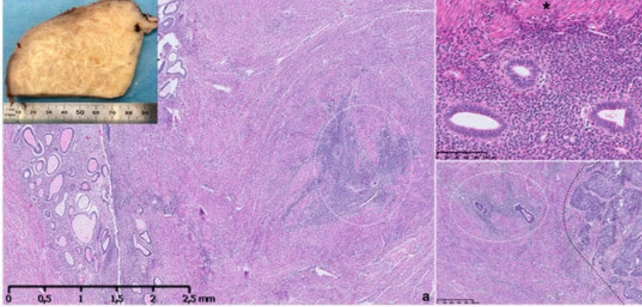November 23, 2024

BBC presenter Naga Munchetty revealed last year that she suffers from adenomyosis, a chronic condition that affects the uterus. She spoke of how her pain can leave her unable to move and how a recent flare-up was so intense her husband had to call an ambulance.
Yet many people have never heard of this condition, despite it affecting as many as one in five women.
Adenomyosis can cause symptoms including irregular and heavy menstrual bleeding and pelvic pain. The severity of symptoms varies between patients – up to one-third of women with adenomyosis may have minimal or no symptoms at all.
The condition can also affect fertility. Women with adenomyosis who do become pregnant have an increased risk of miscarriage, pre-term delivery, pre-eclampsia, and bleeding after delivery.
So what causes adenomyosis, and how is it diagnosed and treated? There's still a lot we don't understand about this condition, but here's a bit about what we know so far.
There are two key layers in the uterus. The endometrium is the inner layer where embryos implant. If there is no pregnancy, this layer is shed during a period.
The myometrium is the muscular layer of the uterus. It expands during pregnancy and is responsible for contractions. In people with adenomyosis, endometrium-like cells are found in the wrong place – the myometrium.
Although a large number of women with adenomyosis have endometriosis as well, adenomyosis is a distinct disease from endometriosis.
In endometriosis, endometrium-like cells are also found in the wrong place, but in this case outside of the uterus, mainly in the pelvic cavity.
Thanks to research, public engagement, and social media, awareness of endometriosis has increased in recent years. Yet adenomyosis is still relatively unheard of.
Adenomyosis is a difficult condition to diagnose. Historically, the presence of endometrium-like cells in the myometrium could only be verified by pathology assessment where the myometrium is examined under a microscope after a hysterectomy (surgery to remove the uterus).

Recent years have seen increased diagnoses with the development of imaging technologies such as MRI and detailed pelvic ultrasound.
Although adenomyosis is now commonly identified without the need for a hysterectomy, doctors are still working towards developing a standardized method for non-surgical diagnosis.
As a result, it remains uncertain exactly how many women have adenomyosis. Although we know that around 20 percent of women having hysterectomies for reasons other than suspected adenomyosis are found to have evidence of the condition on pathology assessment.
The type of adenomyosis tissue growth in the myometrium can be either focal lesions (affecting a part of the uterus) or diffused (affecting a wide area of muscle).
Adenomyosis can be further classified depending on the depth of endometrial-like tissue invasion into the myometrium.
Scientists and doctors are still investigating whether the type or depth of the lesions relates to symptoms – the severity of symptoms and lesions don't always tally.
We don't yet understand why some women develop adenomyosis, though evidence shows there is an increasing prevalence with age.
It is thought that the region between the endometrium and myometrium becomes damaged, either by the natural processes of the menstrual cycle, pregnancies, and childbirth, or medical procedures.
In some women, damage to the endometrial tissue layer does not heal as it should, and the endometrium-like cells enter and grow abnormally into the myometrium. These disrupt the normal functions of the myometrium leading to pain and bleeding.
It's possible that a variety of mechanisms may contribute, and that there is not one common disease-causing factor behind adenomyosis.
Treatment strategies include hormonal medications such as oral contraceptives, progesterone-containing pills, the insertion of a progesterone-releasing coil (for example, Mirena), or a drug called GnRHa that stops the natural production of sex hormones.
Non-hormonal treatments include tranexamic acid. These treatments aim to minimize menstrual bleeding. Pain is often treated with non-steroidal anti-inflammatory drugs.

Treatments that work for some women don't for others, adding weight to the argument that there's more than one type of adenomyosis. Treatment strategies should be tailored to patients, depending on their fertility wishes and symptoms.
If medical treatments are not providing adequate relief from symptoms, there are surgical options, namely removal of the focal lesions or a hysterectomy.
Although adenomyosis is a common disorder that affects many women, including those of reproductive age, it doesn't receive enough clinical and research attention.
There is also a lack of knowledge and awareness around adenomyosis among many healthcare professionals and the public. This needs to change so we can improve our understanding of the condition, diagnosis, and treatment options.
Scientists and doctors who specialize in adenomyosis are still on the quest to find an accurate, non-invasive diagnostic method, and hopefully, one day, a cure.
Jen Southcombe, Principal Investigator/Group Leader, Nuffield Department of Women's and Reproductive Health, University of Oxford and Nura Fitnat Topbas Selcuki, PhD Candidate, Nuffield Department of Women's and Reproductive Health, University of Oxford
This article is republished from The Conversation under a Creative Commons license. Read the original article.
An earlier version of this article was published in May 2023.